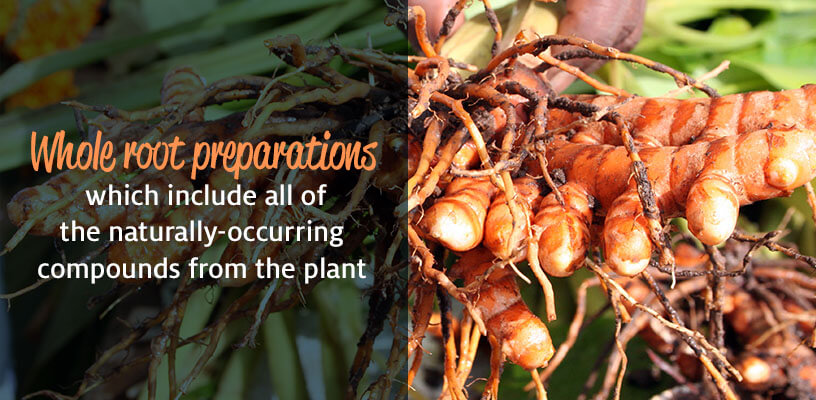Blog
Which is better for inflammation: Turmeric or Curcumin?
Charity Parkinson Cl.H., H.N.C.February 2, 2017
Walk into any health food store and you will likely find a ton of turmeric and curcumin products lining the shelves. While many know these products are related, there is a still a great deal of confusion over which one is best used to reduce inflammation.
The Turmeric-Curcumin Relationship
Turmeric, also known as Curcuma Longa, is rich in a variety of compounds including curcumin. Curcumin is likely the best-known compound and is found in the root and responsible for its very yellow pigment. (The less known yet beneficial compounds include demethoxycurcumin, bisdemethoxycurcumin, turmerin, turmerone, elemene, furanodiene, curdione, bisacurone, cyclocurcumin, calebin A, germacrone and more.)
Benefits
Turmeric is being studied as a medicine for some of the most common health conditions affecting people today. Research tells us that turmeric may be helpful in a number of inflammatory conditions; including arthritis, heart disease, diabetes, autoimmune conditions, cancer, Alzheimer’s disease, inflammatory bowel disease, skin conditions and more.
As a Clinical Herbalist, I fully agree that turmeric root is one of those herbs worthy of all the hype, yet there are different forms on the market and that has created some confusion.
Different forms
Essentially there are two major forms of turmeric supplements, one being the whole root preparations which include all of the naturally-occurring compounds from the plant. The other being the isolated curcumin extracts containing only that one single compound found in turmeric root.
Curcumin Extracts
Research so far has mostly focused on curcumin as the most important compound found in turmeric root. In isolation, however, this compound is very difficult to absorb. For this reason, some products include a fat (called a phospholipid), bound to the curcumin extract to help it to absorb better into our cells. Other products include curcumin broken down into microscopic particles in order to increase absorption that way. Still, others contain a complex of two or three compounds in the curcumin family in the attempt to drive it into our cells.
A few studies do show that when curcumin is processed in the above-mentioned ways, that it is better absorbed than when it is on its own. However, these products are missing the other compounds in turmeric that may also offer therapeutic benefit. One study shows that when curcumin is removed from turmeric that it still has anti-inflammatory and health-related benefits. So what else in turmeric is doing the job?
Whole Turmeric Root
The second major form of turmeric supplements is whole turmeric root, with some key differences depending on the product.
Photo Credit: Vilb1 Flickr via Compfight cc
Standardized extracts of turmeric root are products which start with whole turmeric root and then concentrate it in order to achieve higher levels of curcumin or curcuminoid compounds. This form can still be considered a whole herb product, as long as all the other naturally occurring compounds in the root are left intact and included in the final product. You also want to be sure that the process used to concentrate the extract is free of chemicals and high temperatures.
Other products include the whole turmeric root, extracted in such a way that the full spectrum of compounds (both fat and water soluble) are present in their natural balance and in the final product. The amount of curcumin per serving is often noted to be clear that there is, in fact, a measurable amount of this compound naturally-occurring. Black pepper extract (also known as bioperine) is sometimes included because it is known to increase the assimilation of turmeric into the cells of our digestive tract. It turns out that the essential oils in turmeric also play a major role in absorption.
In essence, as new research is being done, it is pointing to the fact that there are other important compounds in turmeric that are assisting curcumin to absorbed into our digestive tract and utilized by our cells. Therefore the whole herb offers a benefit over any one isolated compound. This might be key when it comes to fighting inflammation.
In my time as a herbalist for over 15 years, I have learned that a holistic approach is best. When we take an isolated approach to herbal medicine, we risk missing out on other important compounds that may play a role in the overall benefit of the plant. We also risk causing unforeseen side effects because the chemistry of that herb is no longer balanced. When in doubt, looking at how a herb has been used traditionally will give us a good indication as to how to best use it. This perspective also gives us a window into the future because it tells us about the safety of a plants’ use over very long periods of time. On that note, happy turmeric hunting everyone!
References:
Herbal Dietary Supplement Sales in US Rise 6.8% in 2014
Turmeric: “The Golden Goddess”
Turmeric
Curcumin-free turmeric exhibits anti-inflammatory and anticancer activities: Identification of novel components of turmeric.
Comparative absorption of curcumin formulations
Effect on Pro-inflammatory and Antioxidant Genes and Bioavailable Distribution of Whole Turmeric vs Curcumin: Similar Root but Different Effects
The Role of Turmerones on Curcumin Transportation and P-Glycoprotein Activities in Intestinal Caco-2 Cells

